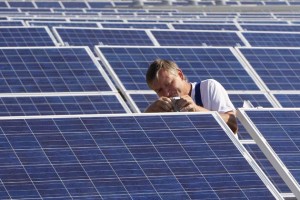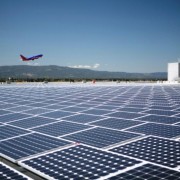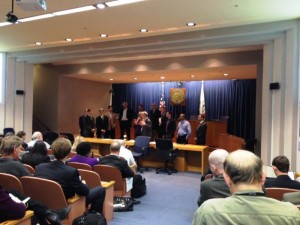November 2013 – Volume 16, Issue 3: Visiting Pine Tree
IN THIS ISSUE
Flanigan’s Eco-Logic
The Most Efficient State
Progress with Climate Protection
LA Retrofits 141,089 Streetlamps
Solar Panels and Glare
The San Onofre Solution
Bryant University Achieves STARS Silver

Flanigan’s Eco-Logic: Visiting Pine Tree
Field trip; we meet at 111 North Hope Street, check in, and board the bus. Joe Ramallo, a director of Public affairs, welcomes us. He, like LADWP and utility personnel, is proud of the utility, excited about its path and its history, from printing its own currency to its key power generation role in Hoover Dam. All aboard, we’re excited to see the Pine Tree Wind and Solar Farm in the Tehachapi Mountains.
Fred Barker, LADWP’s unofficial historian, is in his element telling the DWP story as we head north leaving the city while progressing through a history of Los Angeles and its lifeblood for development, the 100-year old LA Aqueduct. Fred is good morning material: He stands at the front of the bus, mike in hand, regaling us with stories of William Mulholland and Fred Eaton. He’s even in touch with their descendants.
This is DWP country. As we near Mojave, to the left we see the wind development at the base of the Tehachapi Mountains and on up their slopes. There’s much more here than the last time I passed by. In the foreground is a solar farm owned by EDF, the French utility.
We pass LADWP’s Mojave service center, a major maintenance facility for the 233-mile aqueduct from the Owens Valley to Los Angeles. We parallel DWP’s two transmission lines, the high voltage direct current line (HVDC) coursing its way 850 miles north to the Columbia Gorge separating Oregon and Washington. For many years, Los Angeles sent excess power north in winter for heating, and received power for cooling in summer.
The bus slows, and we turn off the 395 at Jawbone, where the two pipelines of the aqueduct sag through a valley… dropping over 1,200 feet, through the dry valley and river wash, then steeply up the other side, and spilling water at an altitude just 26 feet below where it started. We pass the aqueducts and head up the valley. LADWP chose to build, own, and operate a wind farm here, within miles of familiar territory, an interesting synergy between water and power.
Pine Tree’s site is 8,000 acres of rugged terrain. The tour bus grinds its way up the steep and winding, narrow road that services the turbines and solar facilities. Fortunately it’s paved, a rare amenity in this business. LADWP’s Randy Howard told us that we’d instantly know why the wind farm is here. He was right. We stepped off the bus and instantly knew. A cold, fall, determined wind indeed. Looking up, blades spinning, clouds passing, and through my camera lens, I quickly feel dizzy. Head down, I regain my bearings. On the next ridge over is the Pacific Crest Trail.
This site was one of many developed for wind by General Electric. It has an impressive 32% average capacity factor. LADWP bought GE’s project, and then signed a 50-year lease with the family that has ranched the land for generations. LADWP found that its biggest construction challenges were building 34 miles of roads, not the turbines or the 31 miles of underground cable to feed a collector station. (The turbine towers are anchored with below-ground tethers splayed like tent stakes, thus eliminating deep footers for the turbines, some a football-field tall.) Bears were prevalent during construction, and concerns about golden eagle deaths have been studied.
Mark Sedlacek, LADWP’s Director of Environment, explains that avian mortality rates – of all birds – are about 7 – 8/MW/year, the wind industry norm. He’s optimistic that mitigation measures have reduced rodent populations that attract birds. There hasn’t been an eagle death in a year.
Bracing against the wind, and cold, we’re overlooking a “solar patch,” formally known as the Pine Tree Solar Project, a 8.5 MW, 34-acre solar field tucked into the ridgeline topography. It was built in 2012 – 2013 by LADWP employees and nicely follows the contours of the land. We step inside the base of the turbine and into the tower. A ladder ascends into the dark. These are GE turbines, 1.5 MW each. The first 80 were built and went online four years ago, then 10 more were added using stimulus money. The largest city-owned wind farm in the country, there’s a total of 135 MW of wind capacity on line… with the potential to double it, capacity embedded in LADWP’s Integrated Resource Plan. Each of these turbines cost about $2 million, their blades from Brazil, their hubs from Germany, and towers from Korea.
So what about costs asks the group? Howard explains that “all in” costs of wind and solar have dramatically declined in the past few years. (“All in” is everything: land purchase/lease, equipment, interconnection, maintenance, wildlife preservation, monitoring, operation, etc.) Pine Tree wind costs about 13 cents/kWh, though this is higher end with extensive staff and infrastructure, both of which will be amortized over greater amounts of wind and solar capacity. Put in perspective, the output of a gas turbine might be in the 4 cent range; coal as little as 2.5 – 4 cents/kWh. Utility-scale solar can be bought for about 10 cents.
LADWP is on the move with renewables, with 20% on board now (of which 13% is wind) and well on the way to 33% by 2020. Near the Jawbone, we pass the site where LADWP is building “an industrial park” for five solar developers, each of which will be entitled to build 50 MW. In an interesting twist, each winner will also have to develop distributed solar in LA. The City of Los Angeles is creating a new job classification: Wind Farm Technician. A new transmission line will now connect the Tehachapi region’s abundant renewables – some 2.5 GW installed now and with the potential to double that – to the Castaic pumped storage plant. For years, this plant has used coal to power its operations. In the future, this will be replaced with renewable power creating a carbon-free, 1,250 MW storage system to “firm up” inherently intermittent renewables and secure their financial future.
Quote of the Week
“It is perhaps ironic, but inevitable, that California, the birthplace of the car culture, is now the world capital of the world’s cleanest vehicles.”
– Climate Change Scoping Update, October 2013
The Most Efficient State in the Nation
 The seventh annual edition of the State Energy Efficiency Scorecard released by the American Council for an Energy-Efficient Economy (ACEEE) finds that Massachusetts is once again the most efficient state in the nation.
The seventh annual edition of the State Energy Efficiency Scorecard released by the American Council for an Energy-Efficient Economy (ACEEE) finds that Massachusetts is once again the most efficient state in the nation.
The scorecard shows that the top 10 states for energy efficiency are: Massachusetts, California, New York, Oregon, Connecticut, Rhode Island, Vermont, Washington, Maryland, and Illinois. Massachusetts retains the top spot for the third year in a row based on its continued commitment to energy efficiency under its Green Communities Act.
According to the Scorecard, the five states most in need of improvement are North Dakota; Wyoming, South Dakota, Alaska, and Mississippi. That said, Mississippi also appears on ACEEE’s list of the top five most improved states. Last year it passed comprehensive energy legislation including an energy code for commercial and state-owned buildings.

Energy efficient building construction
Massachusetts Governor Deval Patrick said: “Massachusetts continues to lead the nation in energy efficiency because we have made the choice to shape our future, rather than leave it to chance. We will continue to focus on policies that create jobs, decrease dependence on imported energy sources and protect our environment by reducing emissions.” California Energy Commissioner Andrew McAllister said: “ACEEE is providing a valuable service by recognizing energy efficiency leaders that other states can follow. We are proud to be one of the leaders.”
The leading states in utility-sector energy efficiency programs and policies are Massachusetts, Vermont, and Rhode Island. All three of these states have long records of success and continue to raise the bar on the delivery of cost-effective energy efficiency programs and policies. The leading states in building energy codes and compliance are California, Washington, and Rhode Island.
The State Scorecard examines the six policy areas in which states typically pursue energy efficiency: utility and “public benefits” programs and policies; transportation polices; building energy codes and compliance; combined heat and power policies; appliance and equipment standards; and state government-led initiatives around energy efficiency.
Progress with Climate Protection
 This past month, the California Air Resources Board released its first update to the infamous “Climate Change Scoping Plan.” That document, produced in 2008, presented a roadmap for achieving the AB 32 goal of a return to 1990 levels by 2020.
This past month, the California Air Resources Board released its first update to the infamous “Climate Change Scoping Plan.” That document, produced in 2008, presented a roadmap for achieving the AB 32 goal of a return to 1990 levels by 2020.
Good news, the state is on track to achieve the goal of 431 million metric tons per year. In 2000 the level was 468 MMT; we are now down to 456 MMT, a 2.7 % reduction despite a 10.5% increase in population growth over the same period. This resulted in an 11.9% per capita GHG emissions reduction. On a parallel track was electric power which cut its emissions by 17% while increasing consumption from 250.4 TWh to 272.6 TWh in the same 11 year period.
To achieve 1990 levels from a forecasted baseline of 509 MMT, reductions are anticipated from energy (25 MMT); transportation (23); high global warming potential gases (5), and cap and trade (23). The Update suggests that we are on track, though partially due to the recession, but that greater efforts will be required to achieve the 2050 goals.
Los Angeles Retrofits 141,089 Streetlamps, Goes 100% LED
 It’s hard not to be proud of the City of Los Angeles. This time it’s a home-run street lighting success, the world’s largest street lighting replacement. Earlier this year, then Mayor Antonio Villaraigosa announced the completion of the 141,089 street light replacement project, covering 5,000 miles of lighted streets and 4,000 intersections. It is projected to avoid over 40,500 tons of annual emissions.
It’s hard not to be proud of the City of Los Angeles. This time it’s a home-run street lighting success, the world’s largest street lighting replacement. Earlier this year, then Mayor Antonio Villaraigosa announced the completion of the 141,089 street light replacement project, covering 5,000 miles of lighted streets and 4,000 intersections. It is projected to avoid over 40,500 tons of annual emissions.
LA’s project was a partnership between the City of Los Angeles, the Clinton Climate Initiative, and the C40 Cities Climate Leadership Group. The partnership secured the $57 million project through a loan, net of $16 million in rebates from LADWP and a $3.5 million contribution from the Street Lighting Assessment Fund.
What’s Up with Solar Panels and Glare?

Solar at San Jose Airport
How much do photovoltaic panels reflect light? Not much actually.
But let’s dig in:
Good question: We are directed to “the source,” a Federal Aviation Administration report titled, “Technical Guidance for Evaluating Selected Solar Technologies on Airports.” In the airport world, it is known as “the solar guide.” It finds that “yes,” solar systems do vary dramatically in terms of reflectivity. Concentrating solar systems – such as those with parabolic troughs – are highly reflective, while photovoltaic panels are primarily absorptive.
Concentrating solar systems are 90+% reflective. Snow is 80% reflective; bare aluminum 75%, vegetation 50%, bare soil 30%, and wooden shingles 20%.
Photovoltaic panels are about 2% reflective, with a fraction of the reflectivity of bare soil and nearly as reflective as black asphalt. PV panels are in the business of collecting photons; they’re dark to absorb sunlight, and coated with antireflective materials. Surveys cited by the FAA found “no serious complaints from pilots,” suggesting that potential problems with glint and glare (momentary flashes versus continuous bright light) were resolved prior to construction through methodical design processes.
So now we shift to application in areas where glare cannot be tolerated. The FAA reported that 15 airports had solar systems in 2010, from Albuquerque’s “Sun-port” to the Fresno/Yosemite Airport. And airports around the world have gone solar, from Geneva, to Dusseldorf, and Vancouver. Just this past month, the Indianapolis International Airport christened its 12.5 MW PV farm, the world’s largest airport system, built on 75 unused acres.
Denver International Airport has been a pioneer with solar. Its 2 MW Pena Boulevard System just south of the Jeppesen Terminal features 9,250 Sharp 216-watt panels on single-axis trackers. The system is highly visible to all who approach by vehicle and soon light rail. A second “Fuel Farm” system at DIA went on line in 2009 and is 1.6 MW of fixed panels. The design change was made due to “operational difficulties exacerbated by drastic extremes in weather conditions.” In 2011, DIA added another 4.4 MW, 18,980 Yingli panels, bringing DIA’s capacity above 8 MW.
The San Onofre Solution

CPUC Living Pilot Meeting
The “San Onofre Community Response” was presented by Ted Flanigan this week in San Francisco. Why not let the communities surrounding the San Onofre nuclear plant become part of the solution to the capacity shortage caused by its closure? There is an opportunity to galvanize the public into action – through optimized energy efficiency, renewables, community solar, etc. — given the plant’s closure.
The “Living Pilot” Symposium was held at the California Public Utilities Commission to help Southern California Edison shore up two capacity-short substations near San Onofre. The symposium was convened to explore innovative solutions to replacing the capacity and voltage support of the 2,250 MW San Onofre Nuclear Generating station, known fondly as “SONGS.” SCE for the first time is looking for means to demonstrate the value of targeted energy management. It’s looking for proposals to offset/replace power at the Johanna and Santiago substations and the areas they serve.
Bryant University Achieves STARS Silver
 In October, Bryant University achieved STARS Silver status, an important milestone in sustainability rankings for the Smithfield, Rhode Island university known for its innovation and progressive business and liberal arts education. The STARS rating system (Sustainability Tracking and Reporting System) was developed by the Association for the Advancement of Sustainability in Higher Education (AASHE) and has become the industry standard benchmarking tool for campus sustainability. With the submittal, Bryant attained a rating of 47.58, topping the 45 points required for Silver status.
In October, Bryant University achieved STARS Silver status, an important milestone in sustainability rankings for the Smithfield, Rhode Island university known for its innovation and progressive business and liberal arts education. The STARS rating system (Sustainability Tracking and Reporting System) was developed by the Association for the Advancement of Sustainability in Higher Education (AASHE) and has become the industry standard benchmarking tool for campus sustainability. With the submittal, Bryant attained a rating of 47.58, topping the 45 points required for Silver status.
Achieving STARS Silver status marks a year of significant effort and progress on campus. According to Vice President of Business Affairs/Treasurer, Barry Morrison, “This is a great accomplishment for Bryant. It establishes our University as a leader in sustainability.” The achievement highlights the University’s innovation from the energy management of its information technology center, to its geothermal heating and thermal energy storage systems, to its academic courses with sustainability emphases and its U.S.-China Institute, squarely acknowledging the role of global trade and environment.
The University’s Sustainability Plan was developed as part of the process. Bryant’s first such plan, it codifies the University’s forward-thinking stance in the sustainability arena. The Plan documents success achieved thus far, and presents specific goals and actions in eight resource areas (from energy, water, to health and wellness), mapping out a means to save resources while demonstrating leadership and achieving carbon reduction goals.
A year ago, EcoMotion helped Bryant in its documentation, reporting, and submittal for STARS Bronze status. At that time, Bryant achieved a STARS score of 36.05… leaving an 8.95-point gap for Silver status. “To achieve the points,” noted EcoMotion’s Director of Campus Services, Sierra Flanigan, “Bryant had to strengthen its commitment to sustainability.”
With EcoMotion’s guidance, the University instituted more than a dozen initiatives, beginning with the formation and facilitation of the Bryant Sustainability Committee which now guides the effort on campus. EcoMotion has helped the Development Office create a Green Alumni alliance to support green initiatives on campus. Other programmatic areas include an Eco-Leader program, a Green Revolving Fund, a Green Office program, as well as a Sustainability Certificate and Sustainability Internships. The EcoMotion team continues to coordinate and support student groups, student awareness initiatives, as well as faculty development on sustainability. Sustainability clearly has momentum on campus.
